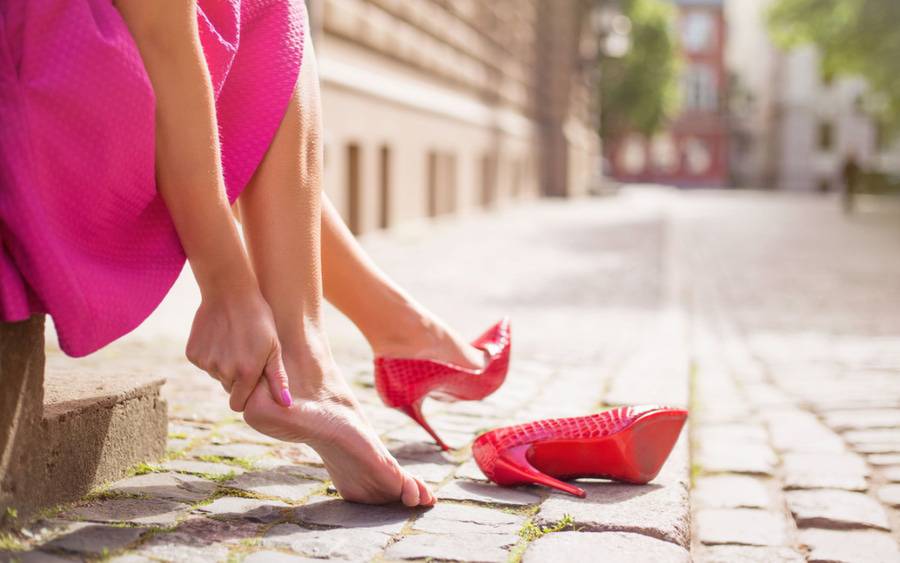What Are Common Foot Problems Caused by ill-Fitting Shoes?
High heels can cause pain, so can going barefoot

High heels can cause pain, so can going barefoot
It’s a fact. The best way to protect your feet is to pay attention to them. “Most people tend to ignore their feet until they hurt,” says Gregory Clark, DPM, who heads the podiatry division at Scripps Clinic.
Foot and ankle problems often develop or are made worse from long-term wear of ill-fitting shoes. This includes high-heeled shoes, narrow shoes and flip flops. Going barefoot for long periods can also lead to foot problems.
“Foot pain can often be relieved with rest, icing, pain relievers, foot braces and other home remedies,” Dr. Clark says. “But if you want to prevent foot pain from developing, one of the best ways is to pay attention to what your wear or not wear on your feet.”
High heels and foot problems
High-heeled shoes have long been a popular fashion choice. They’re sexy, make you look taller and have a wide range of stylish choices. “Barbie-foot heels” are currently trending. But wearing tight-fitting, high-heeled shoes for too long can lead to a variety of foot and ankle problems, including:
- Metatarsalgia, which is pain on the ball of the foot. High heels are designed to point the foot down, but this position puts a lot of pressure on the ball of your feet.
- Toe and toenail deformities, such as bunions and hammertoes, can be painful. Wearing high heels cause the foot to slide down until the toes jam in the front of the shoe. The toe box is often pointed, which further crowds the toes and toenails.
- Ankle and foot sprains and even breaks can occur. The higher the heel the higher the risk of losing balance and injuring the foot or ankle.
- Heel pain can occur. High heels shorten calf muscles, which must then stretch when walking in flatter shoes or barefoot. This can cause a painful, pulling sensation at the bottom of the heel.
Avoiding high-heel pain
Prevent heel-related foot problems. If you decide to wear high heels, consider the following:
- Wear a lower heel height. The lower the heel, the less pressure on the ball of the foot, toes and toenails.
- Look for a wider toe box with a shape that matches your toe shape. The more pointed the shoe, the more crowding of the toes and pressure on the ball of the foot.
- Limit time wearing high heels. Longer time in high heels puts more pressure on the bones of the feet and raises the risk of pain and stress fracture.
- Avoid sprains and fractures by strengthening your lower leg muscles to improve balance when wearing heels.
- Use caution in crowded places, when drinking alcohol, when tired or walking on uneven ground, wet surfaces and ice.
Effects of walking barefoot
Many people are working from home these days and it has many advantages. One disadvantage may surprise you and that is stress on your feet.
“When you are home, you often go barefoot,” Dr. Clark explains. “Most people nowadays have hard floors, whether wood, laminate or tile. What we’re seeing as a result is a higher incidence of some of the more common foot conditions.”
The conditions include:
- Plantar fasciitis — an inflammation of the ligament on the bottom of the foot – is a painful heel condition. The heel can become tender or swollen from excessive use of shoes with poor support or shock absorption or walking barefooted.
- Capsulitis, a bruising of the foot joints
- Back and knee pain
Dr. Clark says the explanation for many foot problems is simple mechanics:
“Your foot is your body’s shock absorber. When you’re not wearing shoes, your foot may be in maximal pronation — completely flat — and it can’t absorb shock, so all of that shock goes to your knees and eventually your back. I like to say that walking barefoot is like walking on stilts, rather than walking on a pogo stick.”
To relieve the strain and add more support while you’re spending more time at home, especially on floors that aren’t carpeted, Dr. Clark recommends wearing a sandal with arch support or a house shoe with a simple, over-the-counter orthotic insert to absorb the shock.
Wear and tear
Gravity also takes a toll on the feet. While foot pain doesn’t necessarily correlate with age, it does increase with mileage.
“The impact of movement on your feet takes its toll over time,” he says, adding that many people start to experience foot pain in their mid-40s, especially if they’ve been active their whole life.
“Just like your car, if you’ve been driving a lot of miles over bumpy roads; your feet are the same way. The strain of gravity is cumulative, and if you’ve been wearing shoes without proper support — or going barefoot or in socks on hard surfaces — you’ll eventually have problems down the road.”
Don’t neglect your feet
Always pay attention to your feet. Consider getting routine pedicures. “At least then, someone is looking at your feet, and if you have a bad nail or a skin crack, someone will see that and direct you to see your doctor,” Dr. Clark says.
If you have type 2 diabetes, check with your physician to make sure it’s okay to have a pedicure.
You might also consider “putting a good hydrating lotion on your feet every day, the same way you’d moisturize your face or your body after a shower. This will help bring your attention to your feet, so if there’s a problem, you’ll notice it before it gets worse.”